As you explore the Ha Giang Loop, you’ll quickly notice women in colorful traditional outfits working along the terraced hills. These striking visuals are part of daily life in the H’mong community – the largest ethnic group in Ha Giang. Known for their resilience, craftsmanship, deep-rooted customs, the H’mong people offer travelers a window into a rich cultural world. Phieu Travel brings you this guide to help you connect meaningfully with their heritage along your journey.
1. The H’mong people – The largest ethnic group in Ha Giang
The H’mong people have lived in Ha Giang for nearly three centuries after migrating from the Yellow River basin in China. Fleeing oppression in the north, they sought refuge in the highlands of Vietnam. Today, they make up over 30% of Ha Giang’s population and are the region’s most populous ethnic group.
Most H’mong communities are concentrated in Quan Ba, Yen Minh, Dong Van, Meo Vac, Hoang Su Phi and Xin Man. Despite steep slopes and remote terrain, they have adapted remarkably through generations of farming, textile weaving and livestock rearing.
The H’mong are not monolithic. They include several subgroups such as the Flower H’mong, Black H’mong, Green H’mong,…. Each is distinguished by clothing patterns, customs and dialects.
The Ultimate Ha Giang Loop Guide (2025): Itinerary, Map & Tips
2. Distinctive characteristics of the H’mong ethnic group
Beyond their population size, the H’mong people are known for preserving a distinct cultural identity shaped by their history, environment and beliefs. From resilient daily life practices to expressive traditions, each aspect reflects their deep connection to the mountains of Ha Giang. Let’s explore the traits that make this ethnic group so unique!
2.1 Remarkable resilience and vitality
In Ha Giang’s rugged highlands, the H’mong people have shaped a life grounded in resilience. They carve terraced fields into steep mountains, build stone houses from local materials, and raise livestock in challenging conditions. Each task reflects physical strength and a deep connection to the land.
Their cultural endurance is equally strong. H’mong families continue to speak their language, uphold ancestral rituals, and wear handcrafted clothing – preserving identity through generations while meeting the demands of modern life.

2.2 Unique and functional housing architecture
H’mong homes in Ha Giang are built with a consistent three-compartment layout. The central room is used for ancestor worship and receiving guests, while the left side serves as the kitchen and main sleeping area. The right compartment includes a fireplace and space for visitors. Above, a wooden mezzanine stores corn or rice and often doubles as a sleeping area for male guests.
Walls are crafted from rammed earth, using wooden molds about 1.5 meters long and 0.5 meters wide. The soil must be clean and compacted layer by layer for thermal insulation and structural strength. Roofing materials vary – thatch for basic homes and double tiles for wealthier families, which also signify social status in the village.
Surrounding each home is a meticulously stacked stone fence, usually 1.5 to 1.6 meters high. These fences block mountain winds, prevent livestock escape, and mark family boundaries. The main wooden gate always opens inward, honoring the H’mong belief in bringing warmth and harmony into the household.
2.3 Striking traditional attire
H’mong clothing is highly distinctive and varies by subgroup. White H’mong women wear white pleated skirts and V-neck jackets embroidered at the cuffs and back. They traditionally shave their heads, leaving a central tuft tied with an indigo turban. In contrast, Black H’mong women favor dark wax-printed skirts and plain indigo tops.
Green and Striped H’mong subgroups embrace more vibrant styles. Their cone-shaped skirts are made from multi-colored fabrics, often embroidered with symbolic patterns like spirals, diamonds, and flowers. H’mong men wear wide-legged blue trousers and white head wraps, completing the traditional ensemble.
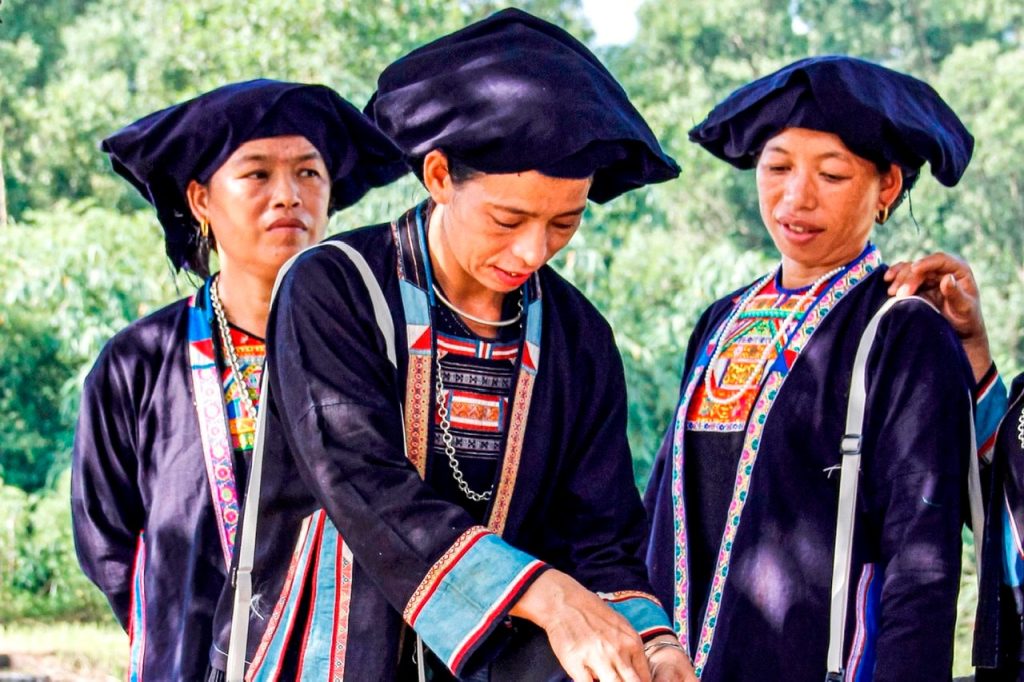
2.4 Mysterious spiritual beliefs and cultural practices
For the H’mong people, ancestor worship is central to daily life. Most homes include a family altar in the main room, where offerings are made to honor elders during key rituals and festivals. Beyond ancestors, many households also worship spirits like ma cửa (door spirit) and ma mẹ (mother spirit), believed to protect the home and bring balance. Each ritual reflects a family’s unique spiritual lineage and values.
These beliefs influence how homes are built and lived in – determining altar placement, meal arrangements, and even the home’s layout. Through these customs, the H’mong preserve a spiritual identity passed down for generations.
2.5 Agricultural ingenuity in the limestone mountains
To survive in Ha Giang’s rugged limestone highlands, the H’mong have developed a unique method called rock-hole farming. They collect fertile soil and fill crevices between rocks to grow maize, beans, sweet potatoes , etc. This technique reflects their adaptability and deep knowledge of the land.
Their agricultural lifestyle blends labor and tradition. Men tend terraced fields and raise livestock, while women weave flax at home. Horses serve not only as working animals but also hold cultural importance – used in transportation, dowry customs, and spring festivals celebrating family and harvest.
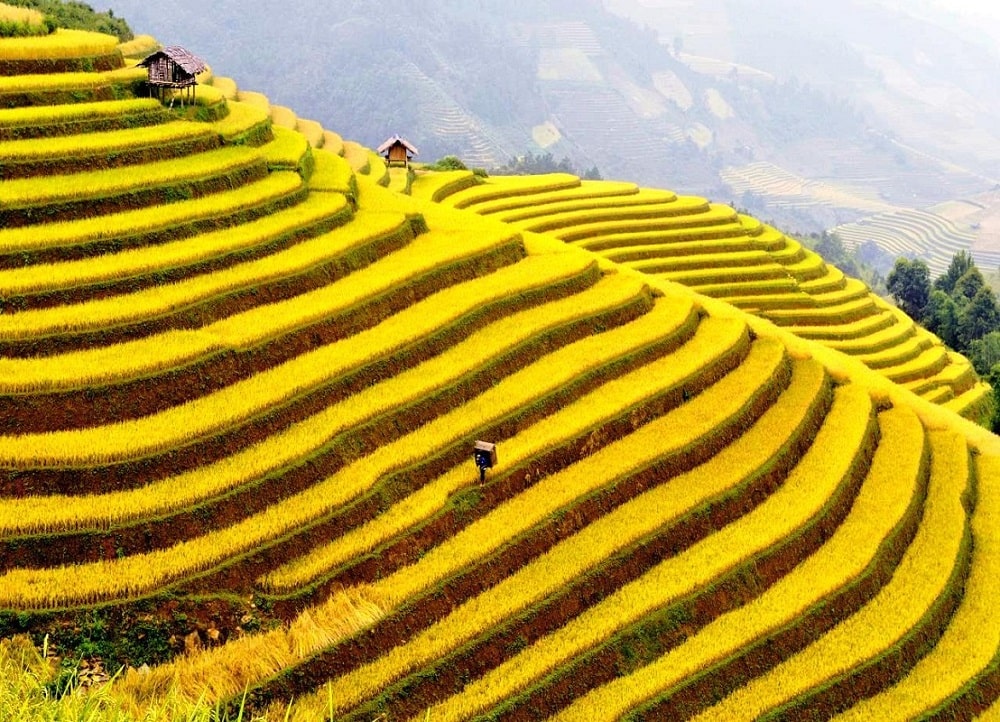
2.6 Unique marriage traditions
In traditional H’mong society, a custom known as “wife taking” has been practiced for generations. When a girl reaches a certain age, a young man may symbolically “take” her home to propose marriage – often without prior consent. This ritual is deeply rooted in a subsistence farming lifestyle, where women were traditionally seen as essential labor for the household.
2.7 Artistic expression in H’mong culture
Music and oral traditions are key to preserving H’mong heritage. Love songs played on the khèn (pan-pipe), bamboo flute, leaf-horn, or lip-violin capture stories of longing, hardship, and hope – passed down through generations.
Among these instruments, the khèn H’mong stands out. Crafted from six bamboo pipes and a wooden gourd, it was traditionally used to guide the spirits of the deceased. Today, it takes center stage at festivals, where men play soulful melodies to express affection or invite others into joyful dances.
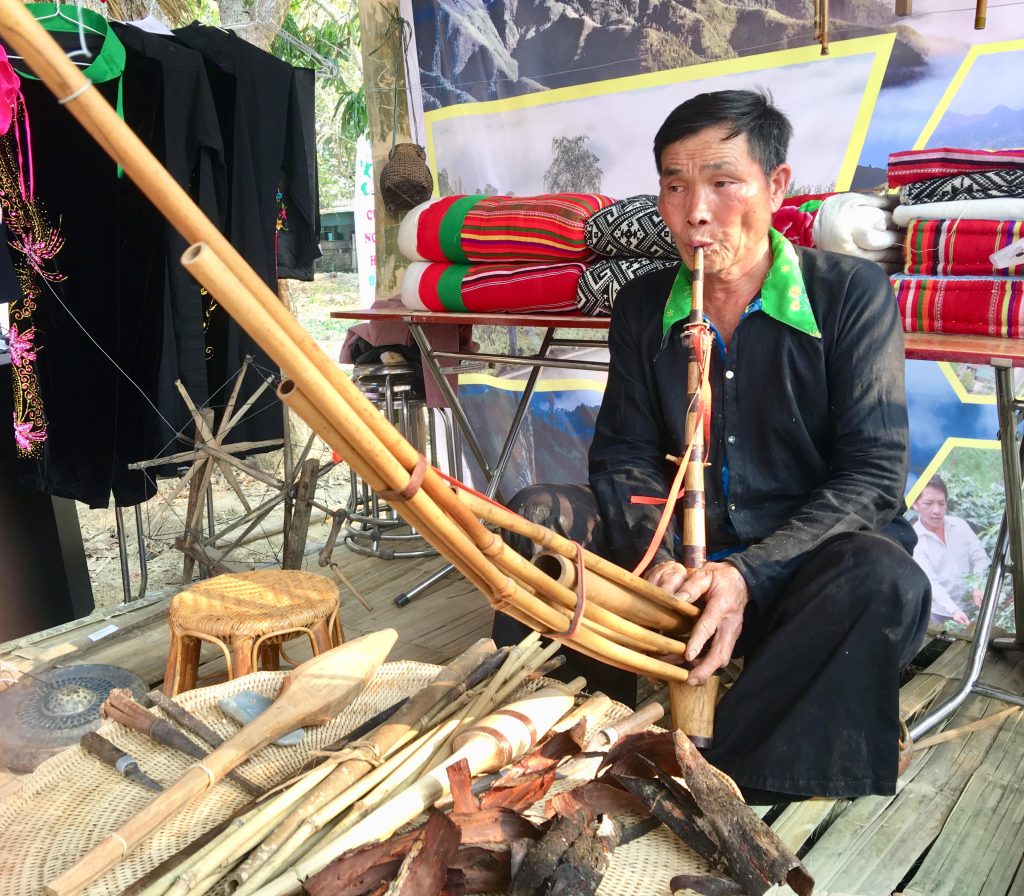
Ha Giang in August: Weather, Things to Do & Travel Tips
3. How to experience H’mong culture in Ha Giang
Explore the highlights below to discover how you can truly connect with H’mong culture in Ha Giang.
3.1 Visit highland markets in Ha Giang
Highland markets in Ha Giang such as Meo Vac, Dong Van, Lung Phin,,… operate on a rotating lunar calendar. This system allows H’mong communities from remote areas to connect through trade and maintain social bonds. Each market becomes a hub for economic exchange, family reunions, and shared local updates.
Stalls feature forest herbs, mushrooms, honey, hand-forged tools and traditional embroidered garments, along with daily essentials. Bartering is still widely practiced. A chicken may be exchanged for a woven basket, or a dozen eggs for farming equipment.
3.2 Attend traditional festivals of the H’mong community
Spring and post-harvest months are the best times to experience H’mong festivals in Ha Giang. Celebrations like the Gau Tao Festival, held from the 1st to the 15th day of the Lunar New Year, were originally spiritual events to pray for fertility and good health. Today, they feature ritual offerings, folk singing competitions and traditional games, helping preserve community values across generations.
Another highlight is the Khau Vai Love Market Festival, where former lovers meet once a year to reconnect through music, storytelling, and shared memories. Visitors are welcomed with bonfires, bamboo dances, and homemade corn wine, creating an open, festive space that reflects the warmth and hospitality of the H’mong people.
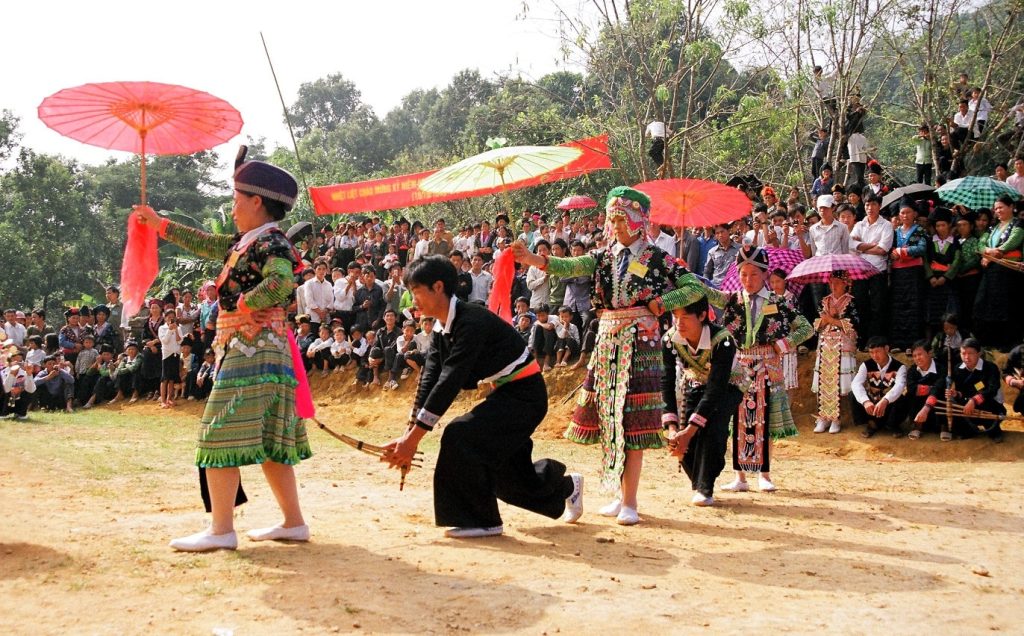
3.3 Enjoy traditional H’mong cuisine
H’mong cuisine in Ha Giang is rooted in mountain farming and a lifestyle centered around shared meals. Dishes are based on local staples like corn, wild herbs, and glutinous rice, often slow-cooked and served in large portions during family gatherings and festivals.
You can taste traditional dishes such as thang co (a rich stew made with horse meat), men men (steamed ground corn), and corn wine distilled in the highlands. Sampling these foods at a local market or during a village meal offers one of the most authentic ways to connect with H’mong life in Ha Giang.
3.4 Stay with H’mong families
During your stay, you can join in activities like planting crops, cooking traditional meals, or learning H’mong embroidery techniques. These experiences offer insight into how the H’mong sustain their way of life through daily routines, practical skills, and strong community ties.
3.5 Explore H’mong culture with Phieu Travel
To experience the heart of H’mong culture along the Ha Giang Loop, join a curated tour with Phieu Travel. Our itineraries take you into villages like Lung Tao, Sa Phin, or Lao Va Chai – places known for their stone paths, traditional homes, and welcoming artisans.
You can engage in hands-on activities such as farming, embroidery, or playing the khèn (pan-pipe), all guided by local experts. Each visit is designed to be immersive, respectful, and grounded in real community connection. Let Phieu Travel help you discover the depth of H’mong life beyond the surface!

4. Cultural travel tips when visiting H’mong communities
To make your visit more meaningful and responsible, it’s important to understand and respect local ways of life. Below are a few practical tips to help you engage with H’mong people in a thoughtful and culturally sensitive manner.
4.1 Respect local customs and cultural norms
When visiting H’mong villages in Ha Giang, cultural awareness matters. A simple act like greeting elders respectfully, speaking in a calm tone or following directions during community events shows that you value local ways of life. Always ask before photographing people, homes, or ceremonies. Some moments such as family meals or spiritual gatherings are deeply personal. Being thoughtful helps build mutual respect and leaves a positive impression.
4.2 Help maintain cleanliness and protect the local environment
Ha Giang’s landscapes are not only beautiful but also ecologically sensitive. Visitors can help protect them by carrying reusable items, disposing of waste responsibly, and staying on marked trails to avoid erosion and plant damage. Keeping noise low, respecting wildlife, and avoiding litter in rivers or fields ensures that H’mong villages and their natural surroundings remain intact for future generations. These simple actions reflect a mindful approach to sustainable travel.
The H’mong people in Ha Giang offer a rare window into a culture that is both resilient and alive. With Phieutravel.com, you can visit local homes, join traditional crafts,and explore how heritage shapes daily life. Each journey is curated to be respectful, immersive, real, helping you experience the heart of H’mong culture through genuine community connection.
Read more:
- Ha Giang’s Dao People: A Complete Guide to Their Culture and Festivals
- Inside the Life of the Lo Lo People in Vietnam
- Brocade Clothes in Ha Giang: 6 Ethnic Styles You Should Know
- Is There a Ha Giang Airport and How to Reach Ha Giang by Air Travel
- La Chi People Vietnam – History, Culture, Traditions & Villages in Ha Giang
- Shan Tuyet Tea: Vietnam’s ancient mountain treasure

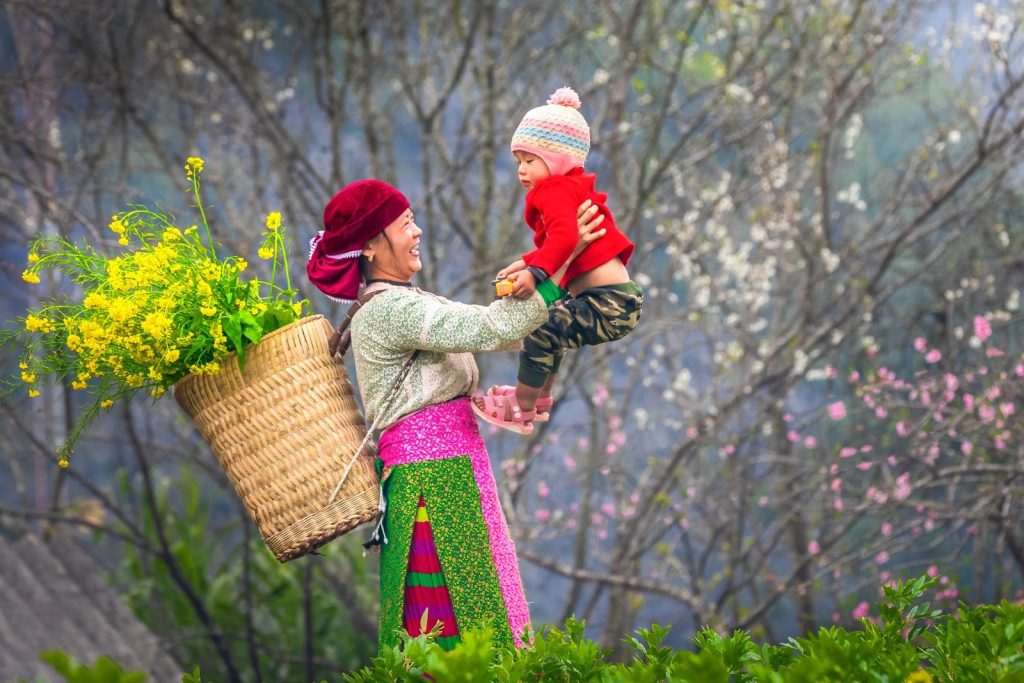
You Might Also Like
Ha Giang Weather in September: Complete Guide for Travelers
Exploring the magnificent Ha Giang Loop in September offers travelers a perfect balance of favorable[...]
Quan Ba Twin Mountains: Ha Giang’s Iconic Fairy Hills and Complete Travel Guide
The mystical Quan Ba Twin Mountains rise from the emerald valleys of Ha Giang like[...]
Vuong family mansion: the architectural marvel and cultural legacy of Ha Giang
Deep in Vietnam’s northern highlands, where mist-shrouded mountains meet terraced rice fields, stands a testament[...]
Ha Giang Loop Safety Tips: How to Ride Securely in Vietnam’s Northern Mountains
The Ha Giang Loop, with its winding mountain roads and breathtaking landscapes, offers one of[...]
The Ultimate Guide to the M-Shaped Curve on Ha Giang Loop
Vietnam’s remote northern province of Ha Giang hides a natural wonder that has captivated adventurous[...]
Most Beautiful Places to Visit in Vietnam: Essential Destinations and Insider Tips
Vietnam captivates travelers with its stunning landscapes, rich cultural heritage, and warm hospitality. From mist-shrouded[...]
Beyond the Beaten Path: Discovering Ha Giang Province in Northeast Vietnam
Ha Giang Province in Northeast Vietnam stands as one of the country’s last frontiers for[...]
Rainy season in Ha Giang: what to expect, when to go, and travel tips
Vietnam’s northern frontier reveals a different face during the rainy season, transforming Ha Giang’s limestone[...]